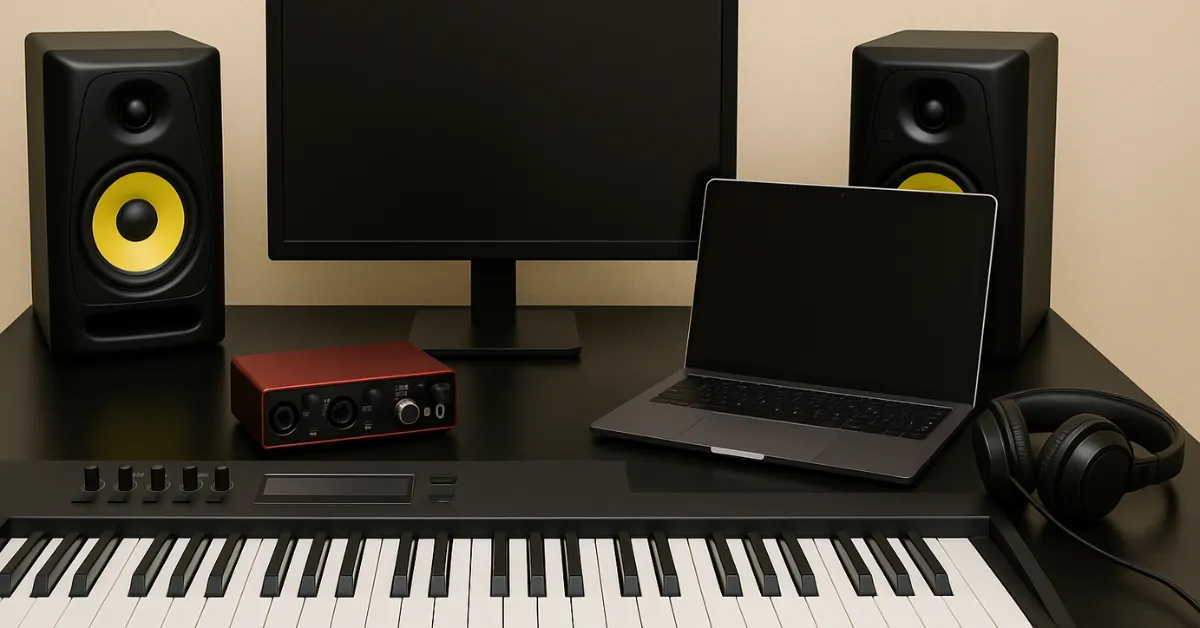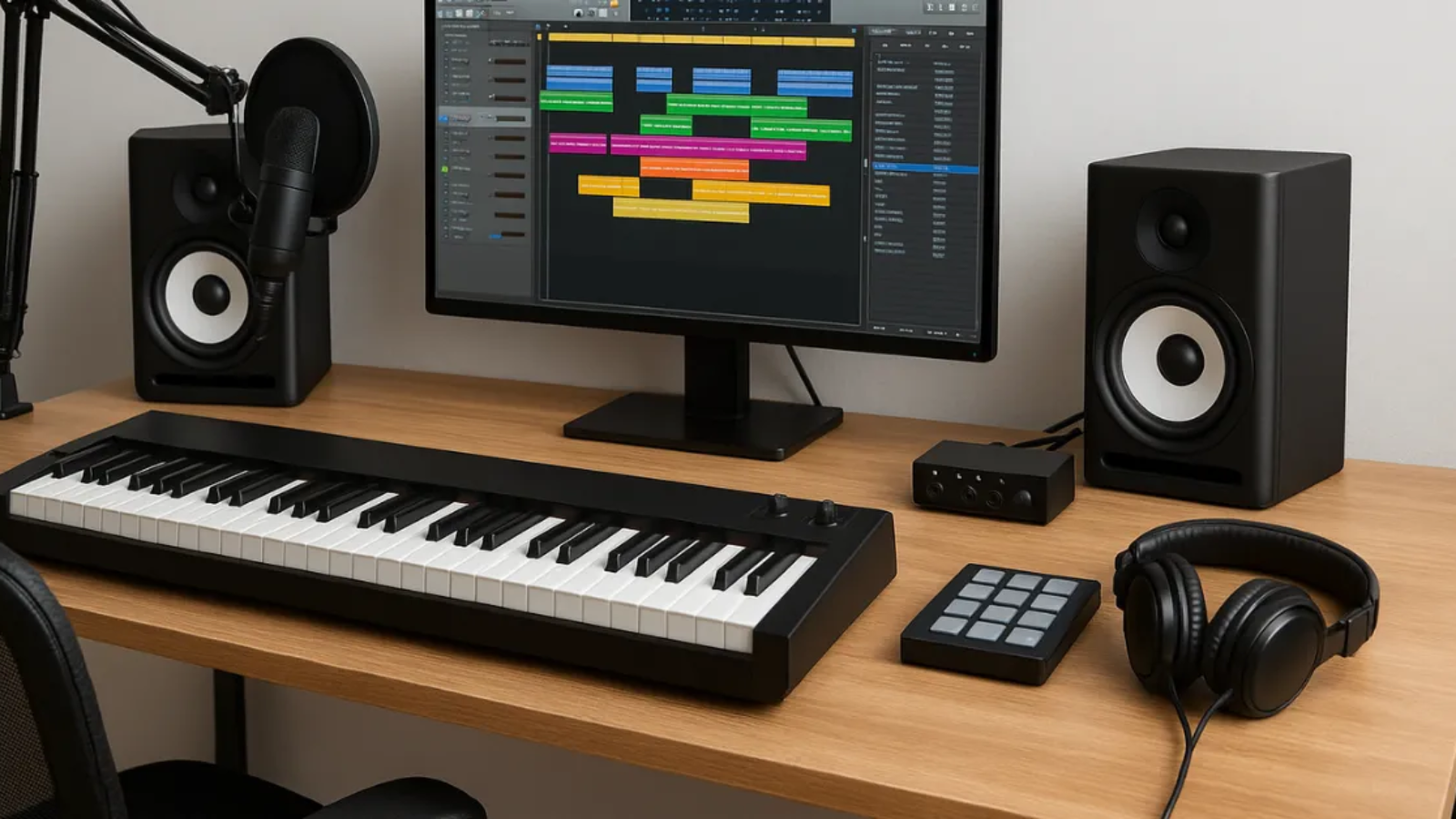Essential Home Studio Setup Guide for Indian Music Creators

Setting up a home studio is an exciting milestone for any musician, especially in India where traditional and modern music co-exist beautifully. Whether you’re a classical vocalist, a sitar player, a Carnatic violinist, or an electronic music producer fusing tabla with synths, having your own space for music creation boosts productivity and creativity. This blog will walk you through everything you need to know about how to set up your home studio—with a special focus on Indian instruments and musical needs.
1. Choosing the Right Room
- Go for a quiet space: Avoid rooms near roads or noisy areas. A bedroom or a small spare room works best.
- Room shape matters: Rectangular rooms are better than square rooms for sound acoustics.
- Natural soundproofing: Use thick curtains, carpets, and bookshelves to dampen echoes.
2. Audio Interface – The Heart of Your Studio
- Why it’s essential: Converts analog sounds (like flute or tabla) to digital.
- Best beginner options: Focusrite Scarlett 2i2, Audient EVO 4.
- Indian instrument input: Make sure it has XLR and 1/4” jack inputs for microphones and pickups from veena, violin, etc.
3. Studio Monitors vs Headphones
- Why monitors matter: Accurate sound helps with mixing sitar and vocal layers.
- Great monitor brands: Yamaha HS5, KRK Rokit 5.
- Closed-back headphones: Use Audio-Technica M50x for detailed Indian vocal or percussion recording.
4. DAW (Digital Audio Workstation)
- Your main software: Choose based on genre—Logic Pro (for Mac), FL Studio, or Reaper.
- Indian-friendly options: Ableton Live is good for fusion and live looping.
- Plugins for Indian music: SwarPlug for Indian instruments, TaalMala for rhythmic cycles.
5. Microphones for Indian Instruments and Vocals
- For vocals: Condenser mic like Rode NT1-A for Carnatic, Hindustani, or bhajan singing.
- For instruments: Dynamic mics like Shure SM57 for tabla, mridangam, dholak.
- Stereo pairs: Great for recording sitar, flute, or sarod.
6. MIDI Controller
- Why it’s useful: Play software-based instruments and compose melodies.
- Best beginner picks: Akai MPK Mini, Arturia MiniLab.
- Use case: Trigger Indian percussion loops, harmonium chords, and tanpura drones.
7. Acoustic Treatment
- Why it matters: Reduces sound reflections, echoes, and outside noise.
- DIY ideas: Foam panels, rugs, egg crates, thick curtains.
- Bass traps: Place them in corners to manage low-end from tabla, mridangam recordings.
8. Instrument-Specific Requirements
- Flute: Needs ambient mics; keep away from fans or air conditioning.
- Veena and Sitar: Use bridge pickups or clip-on mics.
- Tabla and Mridangam: Use stereo mic setup to capture bayan and dayan distinctly.
- Harmonium: Record from the back side or top, avoiding bellows noise.
9. Power Backup and Surge Protection
- Why it’s a must: Power cuts can damage your expensive gear.
- Solutions: UPS for your computer and interface. Surge protectors for monitors.
- Indian-specific: Consider voltage stabilizers for inconsistent supply.
10. Cables and Stands
- Don’t compromise: Low-quality cables add noise.
- Buy XLR, TRS, and patch cables: Match your instruments’ output.
- Mic stands: Use boom stands for tabla, violin, or group vocal recordings.
11. Recording Indian Vocals at Home
- Pop filter is a must: Reduces plosive sounds (like ‘p’ and ‘b’).
- Use a reflection filter: Controls room reverb.
- Monitor levels: Avoid clipping while singing ragas or bhajans.
12. Tabla, Mridangam, and Other Percussion
- Multiple mics: Use stereo pairs or spot mics.
- EQ settings: Boost mids and low end for a warmer tone.
- Indian rhythms: Use apps like NaadSadhana and TaalMala to maintain laya and taal.
13. Setting Up for Fusion Music
- Use both acoustic and digital tools: Like recording a veena with synth pad.
- Layering: Loop tanpura and drone tracks under vocals.
- Effects: Add delay and reverb to enhance Indian instruments without overpowering.
14. Budget Planning and Phased Setup
- Start small: Begin with a mic, headphones, and DAW.
- Upgrade slowly: Add interface, MIDI controller, and monitors gradually.
- Indian brands: Consider local brands like SoundWorks, Hifonics for budget gear.
15. Smartphone Apps for Practice and Production
- Riyaz App: Practice Indian vocals with feedback.
- TaalMala: Great for tabla, mridangam, and rhythm tracks.
- NaadSadhana: Record, get pitch correction, and export directly.
16. Recording Tips for Indian Classical and Folk
- Use natural reverb: Record in tiled rooms or near wooden panels.
- Group recordings: For bhajan or folk ensembles, use omnidirectional mics.
- Layering vocals: Record alap separately from the main verse.
17. Backup and File Storage
- External hard drives: Back up all project files regularly.
- Cloud services: Use Google Drive or Dropbox to share with your guru or collaborators.
- Label everything: Especially if you record multiple takes of similar raagas or compositions.
18. Inspiration Wall
- Hang photos: Of your gurus, favorite composers, or instruments.
- Daily reminder: Keeps motivation high during long sessions.
- Cultural blend: Combine traditional décor with studio aesthetics.
Conclusion
Setting up your home studio is not just a technical task—it’s a deeply personal journey. Especially when you’re recording Indian music, every choice—from mic selection to DAW setup—matters in preserving the soul of the sound. Whether you’re a Carnatic violinist blending loops or a Hindustani vocalist layering taans over a tanpura drone, the right setup enhances not just quality but creativity. With the right tools and approach, your home studio can become a sanctuary for musical growth, experimentation, and excellence.
At NMS Musicals, we offer a comprehensive range of musical instruments, including percussion, string, wind, and keyboard instruments. Our services encompass sales, expert servicing, and the manufacture of leather instruments. Explore our diverse collection and find the perfect instrument to suit your musical needs.
Visit our website to browse our offerings: nmsmusicals.in
For a closer look at our products, check out our shop page: nmsmusicals.in/shop
Stay connected with us through our social media channels:
- Facebook: https://www.facebook.com/nmsmusicalinstruments/
- Instagram: https://www.instagram.com/nmsmusicals/?hl=en
- YouTube: youtube.com/@nmsmusicals
Our shop locations are:
- Puducherry: 149, Perumal Koil Street, Heritage Town, Puducherry, 605001.
Map Link: https://maps.app.goo.gl/ejDwBBFEJmd3szxk7 - Chennai: No: 1, 1st Floor, Kandigai Street, TVS Nagar, Korattur, Chennai – 600076.
Map Link: https://maps.app.goo.gl/7oXmB6X7KQsqeuuw9
For inquiries, contact/Whatsapp us at 9500663895 or email us at laxman.m89@gmail.com.
Discover the world of musical instruments with NMS Musicals today!
For a visual overview of our percussion instruments, watch the following video:


 Cart is empty
Cart is empty 
Leave A Comment
You must be logged in to post a comment